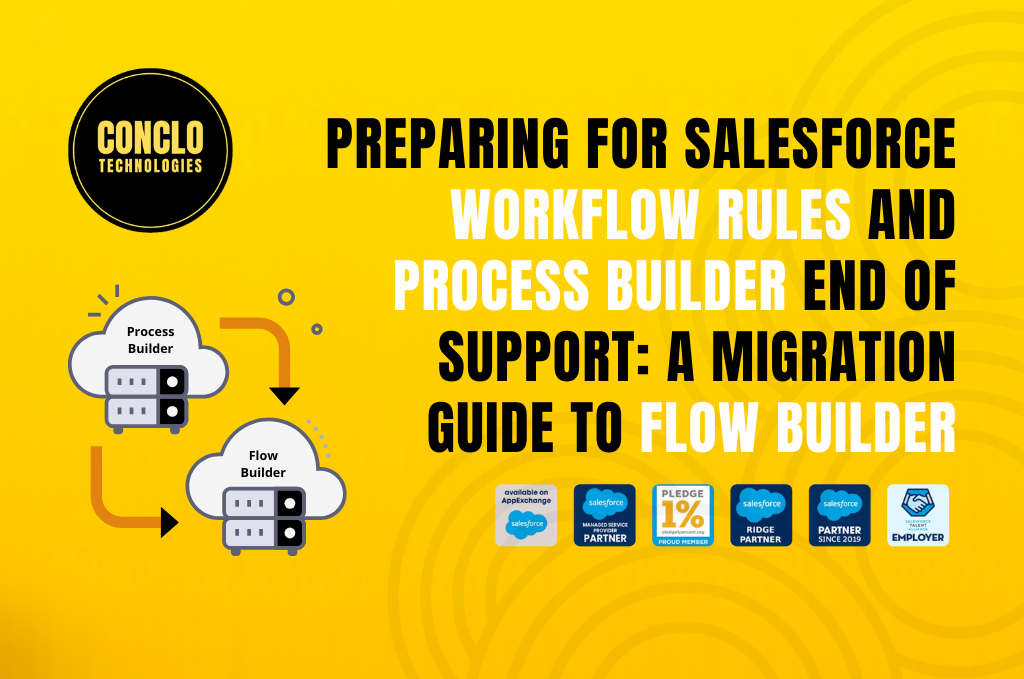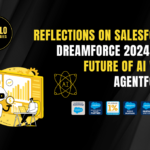Salesforce has recently announced that Workflow Rules and Process Builder two of its core automation tools will be retired, with end of support scheduled for December 31, 2025. If you’re an existing Salesforce customer, you may have already received this notification. This transition marks a significant shift in how Salesforce users approach automation, as Flow Builder will take center stage as the primary tool for building business process automations. Flow Builder offers enhanced flexibility, scalability, and power, but the transition away from existing tools can pose challenges for organizations that rely heavily on Workflow Rules and Process Builder.
If you’re wondering how this change might affect your business or how to best prepare, this article provides guidance on migration considerations and how CONCLO Technologies can assist in making the transition as seamless as possible.
Why is Salesforce Making this Change?
Salesforce’s decision to retire Workflow Rules and Process Builder is aimed at streamlining automation tools and moving towards a more unified and powerful solution—Flow Builder. Flow Builder enables users to automate complex business processes using visual workflows that provide greater flexibility than the older automation tools. However, this also means that organizations that have implemented Workflow Rules and Process Builder extensively will need to rethink their automation strategy and plan for migration.
While the move to Flow Builder is undoubtedly beneficial in the long run, it requires careful planning and execution to avoid business disruptions.
Understanding the Impact of the Retirement
The retirement of Workflow Rules and Process Builder could have a significant impact on your existing business flows if you’ve used these tools extensively to automate key processes. These two tools are deeply integrated into many organizations’ Salesforce environments, managing everything from approvals and notifications to field updates and record creation.
While Salesforce Flow Builder offers an excellent alternative, migrating all your existing automations won’t be a simple task—especially if you have a complex web of automation rules. For businesses relying on automation to streamline operations, this change could affect efficiency, productivity, and user experience if not handled properly.
To understand the full impact, refer to Salesforce’s detailed article on the retirement of Workflow Rules and Process Builder here.
The Complexity of Migration to Flow Builder
Migrating to Flow Builder involves evaluating all existing automations created through Workflow Rules and Process Builder. Depending on the complexity of your current implementation, this migration could be a significant project. Some businesses have relatively simple automation processes, while others have complex, layered workflows that may require deep analysis and redesign during the migration.
At CONCLO Technologies, we understand that each migration is unique. No “one size fits all” solution exists when it comes to migrating automation workflows, and it’s important to tailor the approach to your specific needs.
That’s where CONCLO’s Migration Services come in. Our team can evaluate your current setup, assess the complexity of the migration, and help you map out a clear migration roadmap that reduces risks and minimizes disruptions.
Key Considerations for Planning Your Migration
There are several critical factors that every organization should take into account when planning their migration from Workflow Rules and Process Builder to Flow Builder. These considerations will help you plan an efficient transition with minimal disruptions to your daily operations.
1. Number of Users Impacted
One of the first steps in the migration process is to assess how many users will be affected. Will the migration impact a handful of users, or will it affect the entire organization? Knowing this information will help you determine the level of change management and communication required to ensure a smooth transition.
The more users affected, the more critical it is to have a clear communication plan, training resources, and support systems in place.
2. Number of Business Flows Impacted
Evaluate how many business processes are currently automated using Workflow Rules or Process Builder. Understanding the full scope of automations will allow you to assess the overall impact on your operations and prioritize which workflows to migrate first.
Identify which workflows are mission-critical to daily operations and require immediate attention, and which ones can be deprioritized for later stages of the migration. This will help you allocate resources more effectively during the transition.
3. Enhancing Existing Business Flows
While many organizations may choose to migrate their automations with exact functionality from Workflow Rules and Process Builder, it’s worth considering whether this transition presents an opportunity to enhance your business flows.
The migration process offers a chance to reassess your current processes, streamline them, and even add new capabilities that were previously unavailable. Flow Builder is a much more robust and flexible tool, so this could be a good time to optimize and improve your automations, making your business processes more efficient and effective.
4. Minimizing User Disruption
One of the most important aspects of planning your migration is ensuring that current users experience minimal disruption to their daily workflows. Proper planning, including conducting the migration during off-hours, setting up pilot groups, and rolling out the changes gradually, can help reduce the impact on users.
Additionally, providing training and resources will help users adapt to the new tools with confidence.
5. Change Management and Training
Change management is critical to any successful technology migration. The transition to Flow Builder may require different skill sets or additional training for users to fully leverage the new capabilities.
Plan ahead by identifying the training needs of your teams and providing them with the necessary resources. This will help smooth the transition and ensure that your teams can continue working effectively with minimal learning curve.
How CONCLO Technologies Can Help
At CONCLO Technologies, we specialize in Salesforce migrations and can help you navigate the transition from Workflow Rules and Process Builder to Flow Builder with ease. Our team of experienced Salesforce consultants will work closely with you to develop a tailored migration roadmap that addresses the unique needs of your business.
Our migration assets are designed to reduce the overall effort and time required to complete the transition. We will:
- Evaluate your current automation setup
- Identify business processes and users that will be impacted
- Help you plan the migration to minimize disruptions
- Enhance existing business flows where necessary
- Provide training and support to ensure a smooth transition
Each migration is different, and we are committed to offering customized solutions that fit your organization’s specific requirements.
Get Started with Your Migration Today
Preparing for the retirement of Workflow Rules and Process Builder doesn’t have to be a daunting task. With the right planning and support, your organization can make a seamless transition to Salesforce Flow Builder and take advantage of its enhanced capabilities.
At CONCLO Technologies, we’re here to help. Contact our sales team at sales@conclotechnologies.com to schedule a time to review your current automation setup and discuss how we can help you plan your migration to Flow Builder.
Let’s work together to ensure your business continues to operate efficiently during and after this critical transition.



